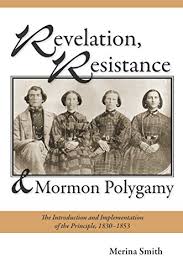Articles/Essays – Volume 47, No. 3
Shifting Attitudes: Nauvoo Polygamy | Merina Smith, Revelation, Resistance, and Mormon Polygamy: The Introduction and Implementation of the Principle, 1830–1853
Editor’s Note: This article has footnotes. To review them, please see the PDF below.
Merina Smith’s book continues the fascination with Nauvoo polygamy. Other authors have considered such topics as Joseph Smith and his wives, the experience of those entering polygamy in Nauvoo (as well as the numbers and names of those who did so), the theology underpinning plural marriage, and much more. The major question Smith deals with is how Latter-day Saints “were persuaded to shift their understanding of marriage not only to accommodate polygamy, but to regard it, at least officially, as the ideal form of marriage” (2). Larry Foster has dealt with this question, though Smith explores it in more depth and frames her answer with theology rather than theory.
Smith’s is a chronological approach. She divides nineteenth century polygamy into five phases: 1) development, 1830–1841; 2) introduction, 1841–1844; 3) aftermath of Joseph Smith’s death, 1844–1852; 4) the Utah period, 1852–1890, and 5) after the 1890 Manifesto. With more than half of the chapters focusing on the 1841–1844 period, she concentrates on the introduction of plural marriage in Nauvoo during Joseph Smith’s lifetime.
Problematic sources from the Nauvoo period about polygamy guarantee that the topic will continue to be explored and reinterpreted. Beyond Doctrine and Covenants 132, Joseph Smith wrote nothing directly about plural marriage. Documents from others were often written years after the events, by those hostile to polygamy, or by people whose involvement in the events they recount was not firsthand. Ambiguous and conflicting selections from the documents support a variety of interpretations. Smith draws on published and familiar manuscript sources, and she takes seriously the claims of participants that they were motivated by religious considerations. She argues that “Mormons’ willingness to accept polygamy hinged on the development of . . . a moral order, or story [an ‘internally coherent system’ in Christian Smith’s words], but that the story, which was connected to nothing less than salvation and exaltation in the next life, developed symbiotically with polygamy” (13). It is never clear whether this “story” is the one known by Joseph Smith or the one eked out in various stages to some followers, though the two are surely distinct.
She supports her argument that the theological narrative developed in relation to the introduction of polygamy by contrasting the reasons for entering into plural marriage Joseph Smith gave to Mary Rollins Lightner and Zina Huntington with those he gave later to Sarah Kimball (85), indicating that the later proposal evinced development of the theological narrative in the interim. Perhaps. But in contrast, she states that Joseph Smith’s approach to a man was shaped by the inducement most likely to convince him (145). Given Joseph Smith’s sensitivity to individuals, his approach to a woman was at least as likely to be informed by incentives he believed would have greatest appeal to her.
Smith arrives at her conclusions about the development of the theological narrative in the women’s accounts by her method of reading between the lines and analyzing the timing of events, a method fraught with problems because of the incompleteness and ambiguity of the sources. Nevertheless, this method works well for her beautifully done case studies. The stories she tells of various Latter-day Saints’ acceptance of plural marriage compellingly capture the essence of what they experienced in accepting and attempting to live the new—or restored—marital practice. Her goal is fundamentally to understand, rather than to stand in judgment based on today’s culture, and she conveys that understanding through intriguing stories of several individuals’ experiences.
For the record, the figures on page 240 for the percentage of divorces for first and subsequent wives—sixteen and eighteen percent respectively—are incorrect. According to my research for More Wives than One, the figures are eight and twenty-five per cent.On the other hand, Smith correctly attributes a quotation regarding being able to speak freely about polygamy in Winter Quarters to Lorenzo Snow (210), despite her first coming across the statement in Richard Van Wagoner’s Mormon Polygamy, which gives the source as Eliza R. Snow.
Revelation, Resistance and Mormon Polygamy is a clearly-written and highly readable account that provides an excellent introduction for readers only vaguely familiar with Nauvoo polygamy. For scholars, it is an important contribution to our understanding of how a monogamous people could embrace plural marriage.
Merina Smith. Revelation, Resistance and Mormon Polygamy: The Introduction and Implementation of the Principle, 1830-1853. Logan, Utah: Utah State University Press, 2013. 280 pp. Hardcover: $29.95. ISBN: 978-0874219173.


 Back to full Issue
Back to full Issue

